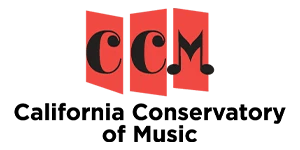Music Education for Adults: Lifelong Learning

Adult music education at The California Conservatory of Music provides an enriching experience tailored for those embarking on their musical journey later in life. Whether you are reigniting an old passion or discovering a new one, the transformative power of music is ageless. It’s a journey that enhances mental agility, emotional expression, and personal satisfaction. CCM creates a welcoming environment where adults are encouraged to explore their musical abilities, irrespective of their starting point.
Music Education for Adults: Why Start Now?
Engaging in music education for adults enhances cognitive abilities, boosts mental health, and provides a fulfilling escape from daily routines. Learning an instrument can rewire the brain, improving memory, attention, and coordination. It’s also a fantastic way to relieve stress and achieve personal growth through creative expression. Furthermore, adult students often bring a level of dedication and appreciation to their lessons that improves their learning experience for both the teacher and student! Adult music education goes beyond just learning to play an instrument; it’s about enriching life and enhancing well-being. Studies show that adults who engage in music education report higher levels of happiness and mental engagement. The discipline of regular practice promotes time management skills and personal discipline. Musically engaged adults often experience a sense of achievement and confidence as they master new skills. Moreover, the social aspect of music lessons—from group classes to recitals—fosters community and connectivity.
Choosing Your Path
Selecting the right instrument and teacher for you is crucial. The California Conservatory of Music offers flexible scheduling to accommodate the busy lifestyles of adult learners, ensuring that classes are both accessible and enjoyable. Additionally, our instructors are skilled at tailoring lessons to individual learning styles, making each session both challenging and rewarding. To ensure that you find the right fit for you, CCM offers every student a free 15-minute introductory lesson before committing to regular weekly lessons. We also have fun adult student recitals that are completely optional and free for families to attend! This is a great way to feel accomplished and work towards a set goal with your lessons.
Taking the First Step
Initiating your musical education merely requires taking that first step of signing up for a lesson. The California Conservatory of Music encourages potential students to visit and experience a class firsthand. Engaging with instructors and current students can provide insight and inspiration. Furthermore, each lesson is a building block in your musical journey, and consistency is key to progress. With commitment, the musical journey can become a profound part of your life’s rhythm. Music education for adults is what you make it – it can be a fun hobby on the side or a main priority and goal for you.
Music Education for Adults: Final Thoughts
Embarking on music education as an adult at The California Conservatory of Music offers more than just artistic skills; it fosters a holistic sense of well-being and personal achievement. Our supportive environment ensures that every student receives the guidance needed to thrive musically. As you contemplate beginning this journey, remember that the benefits of music education extend well into all facets of life, making it a worthwhile pursuit at any age.
Sign up for your FREE introductory music lesson at The California Conservatory of Music today!

Gabriela Ortiz: March Composer of the Month

Gabriela Ortiz, a leading composer from Latin America, blends traditional elements with modern techniques to redefine classical music. Born in Mexico, she has compositions that reflect a rich cultural heritage fused with innovative expressions that have garnered international acclaim. This exploration offers insights into her vibrant, rhythmic works that connect the historical depth of music with contemporary vibrancy. Let’s delve into the life of a composer who continues to reshape modern classical music.
Ortiz’s Early Inspirations
Gabriela Ortiz’s musical journey began in Mexico City, rooted in a rich heritage of Mexican music and culture. Her early exposure to folk music and classical compositions sparked a deep interest in the arts. Additionally, Ortiz quickly developed a penchant for composing because she grew up in a musically inclined family. She often experimented with various styles and instruments, as well. Plus, her formal training at the National Conservatory of Music in Mexico further honed her skills, setting a solid foundation for her innovative compositions. Notably, this early immersion in a diverse musical environment was pivotal in shaping her future works.
Building a Musical Career
Ortiz’s professional career is marked by a blend of teaching, composing, and performing. After completing her studies in Mexico, she furthered her education at the Guildhall School of Music & Drama in London and later at the University of California, San Diego. Each phase of her education introduced new influences that shaped her unique sound. As a professor at the National Autonomous University of Mexico, Ortiz has influenced many young composers, integrating traditional Mexican music with contemporary techniques. Her global academic experience has enriched her approach, infusing her compositions with a broad spectrum of musical idioms. She will be Carnegie Hall’s composer in residence for the 2025 season and will continue to showcase her creative works.
Ortiz’s Unique Musical Signature
Ortiz’s ability to fuse traditional Mexican music with modern orchestral techniques sets her apart. Her compositions often feature vibrant rhythms and textures, making her music unmistakable. Furthermore, she utilizes electronic elements and indigenous Mexican instruments to create a fresh, compelling sound that resonates with audiences worldwide. This distinctive style not only pays homage to her roots but also pushes the boundaries of classical music. Overall, her innovative use of electronic music technology alongside classical forms has set her apart in the contemporary music scene.
Notable Works and Impact
Among Ortiz’s numerous works, “Altar de Piedra” stands out, commissioned by the Los Angeles Philharmonic. This piece exemplifies her signature style of integrating pre-Columbian percussion instruments with a full orchestra. Another significant work, “Baalkah,” explores the interaction between a string quartet and traditional Mexican clay flutes, showcasing her innovative approach to composition. These works have enriched the contemporary music scene and brought Mexican music to the forefront of the global stage. As a result, her ability to blend different musical traditions has garnered her international acclaim and numerous awards.
Final Thoughts
Gabriela Ortiz’s contributions to the world of contemporary classical music are profound. Her works continue to be celebrated on international platforms, inspiring a new generation of musicians and composers. As she blends the past with the present, Ortiz ensures that the essence of Mexican music is preserved and revitalized in modern compositions. Her legacy is one of innovation, cultural celebration, and musical excellence, making her a pivotal figure in contemporary music. Through her vibrant and eclectic compositions, Ortiz has become a beacon of innovation in the classical music world.
Sign up for your FREE introductory music lesson at The California Conservatory of Music today!

February Voice Student of the Month: Ella Maes
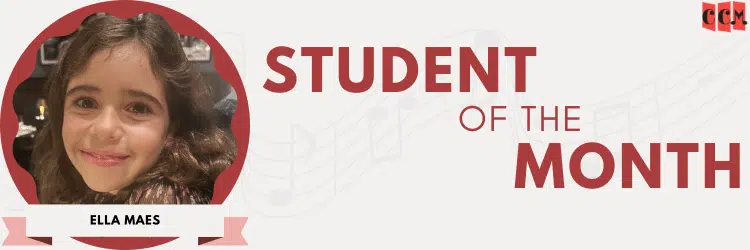
This February, we are happy to feature CCM voice student, Ella Maes, as our Student of the Month! Ella has been taking voice lessons for 8 months at CCM and currently studies with teacher Heather at our Sunnyvale location. She’s also been taking piano lessons for almost a year now with Teacher Jane. Julie is always striving for excellence and works hard in every lesson! She has been progressing steadily and learning music theory with a bright smile and a great attitude. Additionally, she works through difficult challenges until she’s confident! Teacher Heather says, “She is a hard worker, but also has grace for herself and shows kindness to herself and others. Her musicianship is continuously getting stronger each week and I highly respect her character as a fellow musician.”
Student of the Month Questionnaire – Julie Maes
What is your name?
Ella Maes
How old are you?
10
Who is your teacher?
Teacher Heather
How long have you been taking voice lessons?
Since summer 2024
What advice would you give to a voice student just starting at CCM?
I would tell them that they should not be afraid to start lessons, and for recitals, don’t worry you’ll be okay.
What song are you looking forward to learning someday?
A song from The Greatest Showman musical.
What is your favorite thing about singing?
How it flows and how the rhythm is fun.
What is your favorite food?
Mac n Cheese
Do you have a pet?
No.
Do you play any sports or do any other activities outside of music lessons?
Yes I love softball, swimming, tennis, running, and racing.
What do you want to be when you grow up?
I want to have a farm and raise animals and grow food.
What is your most memorable experience at CCM?
The recitals I’ve done- 3 for piano and 1 for voice.
Parent Spotlight – Julie Maes
Learning to be more confident both in her voice, with music in general, and in performing in front of others.
Practicing at home will be a battle sometimes, but stay firm, as music is a great foundation for other disciplines, but also makes the child more well-rounded in academics. It boosts their confidence in general. They have a talent that many of their friends may not have.
I was required to take piano for much of my upbringing, my great-grandmother was a music teacher and so many of my family members on both sides were raised with music lessons.

Regina Carter: February Musician of the Month
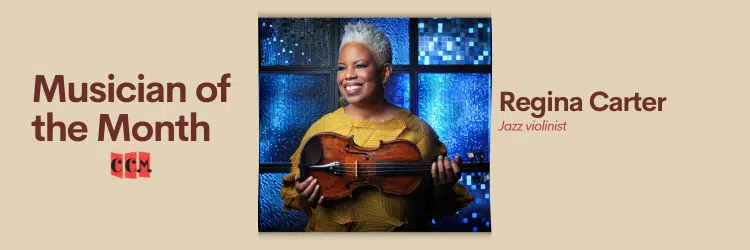
Regina Carter stands as a towering figure in the world of jazz, renowned for her mastery of the violin—a rarity in a genre dominated by horns and pianos. Her unique approach blends classical finesse with soulful jazz, creating music that resonates with audiences worldwide. This blog delves into Carter’s journey, her musical influences, and the distinct style that sets her apart.
Carter’s Early Life and Inspirations
Growing up in Detroit, Michigan, Regina Carter was immersed in a world of diverse sounds from an early age. Initially trained in classical violin, her musical journey took a pivotal turn when she discovered jazz through her high school’s music program. Influenced by legends like Ella Fitzgerald and Miles Davis, Carter began to explore the freedom of jazz improvisation.
Music Career
Regina Carter’s professional career is a testament to her versatility and dedication. After studying at the prestigious New England Conservatory, she launched into jazz, quickly gaining recognition for her exceptional talent. Her albums, such as “Rhythms of the Heart” and “Ella: Accentuate the Positive,” showcase her ability to reinterpret classic sounds and push musical boundaries. Furthermore, her collaborations span genres and generations, highlighting her appeal across the musical spectrum.
Unique Aspects of Carter’s Music
Regina Carter’s ability to infuse classical violin techniques and soulful jazz sets her apart in music. Her playing is marked by a lyrical quality that tells a story, weaving intricate melodies with emotional depth. Additionally, her exploration of African folk music and other global influences provides a rich layer to her performances, transcending traditional genre constraints.
Notable Works and Themes
Among her many accomplishments, Carter’s album “Southern Comfort” explores her family’s roots through folk tunes and spirituals. She blends these with contemporary sounds to create a tapestry of her cultural heritage. Moreover, her dedication to exploring the African influence in classical music through projects like “Reverse Thread” highlights her commitment to musical education and exploration.
Final Thoughts
Regina Carter’s impact on music extends beyond her performances. As a pioneer, educator, and innovator, her contributions to jazz and beyond continue to inspire and influence. Overall, her journey underscores the power of music to bridge cultures and histories. As we celebrate her achievements, we recognize the profound role music plays in enriching our lives and connecting us to our deepest human experiences.
Sign up for a FREE introductory music lesson at The California Conservatory of Music today!
The Role of Music in Mental Health
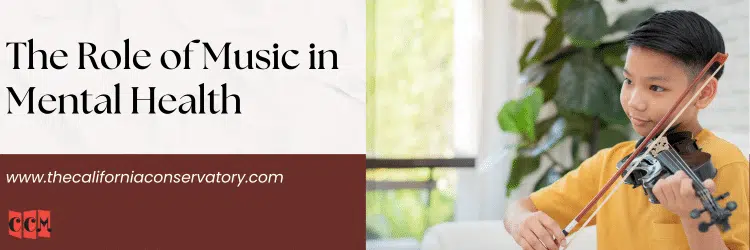
Music intertwines deeply with our emotional and cognitive landscapes, offering more than mere entertainment. Understanding its profound impact on mental health can enhance your child’s experience with lessons. Continue reading as we explore how music influences our well-being and personal development.
Emotional Expression and Regulation
We all know that feeling when you’re listening to your favorite song – your body buzzes with feeling! Music serves as a powerful medium for expressing complex emotions, allowing students to articulate feelings that might otherwise remain suppressed. Engaging with music, whether by playing an instrument or singing, can act as an emotional release, significantly reducing stress and anxiety. It’s not just about venting; it’s about understanding and managing your emotions. Through structured music lessons, students learn to foster emotional maturity and resilience with a creative outlet.
Cognitive Development and Mental Agility
The cognitive benefits of music education extend far beyond mastering rhythm and theory. Studies show that learning how to play an instrument improves memory, attention, and reasoning skills. These cognitive boosts are beneficial in academic and social settings, making lessons a valuable investment in a child’s educational journey. Additionally, the discipline of regular practice and the complexity of learning pieces encourage a sharper, more focused mind. Plus, students can hone in on their memory skills as they commit difficult pieces to memory for potential performances in the future. These key skills that students develop can be applied throughout other areas of life.
Music and Well-being: Stress Relief
In a world that’s increasingly fast-paced and stressful, music stands out as a refuge—a therapeutic escape. For children, especially, learning an instrument can serve as a stress reliever. The act of playing music or participating in a class can shift focus from stressful thoughts to a more meditative, relaxed state. At CCM, we emphasize the relaxing aspects of music, teaching students techniques that help them use their skills as a method for relaxation and stress management.
Social Connections and Music Community
Furthermore, music lessons often involve group classes and performances, which are excellent opportunities for socialization. Engaging with peers can build a sense of community and belonging, crucial aspects of mental health. Through ensemble play and recitals, students at CCM experience the joy and motivational boost of shared musical endeavors, which can significantly enhance their emotional well-being.
Building Confidence and Self-Esteem
The journey through music education is filled with milestones and achievements—from mastering a difficult piece to performing in front of an audience. Each accomplishment serves to boost a student’s confidence and self-esteem. As a result, the pride that comes from these achievements fosters a positive self-image and encourages continual growth. Our teachers at CCM are skilled in guiding students through these milestones, ensuring that each child recognizes and celebrates their progress.
Final Thoughts
In conclusion, music education is a powerful tool for nurturing your mental health. At The California Conservatory of Music, we are dedicated to providing a holistic education that supports the mental, emotional, and cognitive development of our students. By incorporating music into your child’s life, you are not just enhancing their ability to play an instrument; you are investing in their overall well-being and future success.
Sign up for a FREE introductory music lesson at The California Conservatory of Music!

Jessie Montgomery: February Composer of the Month
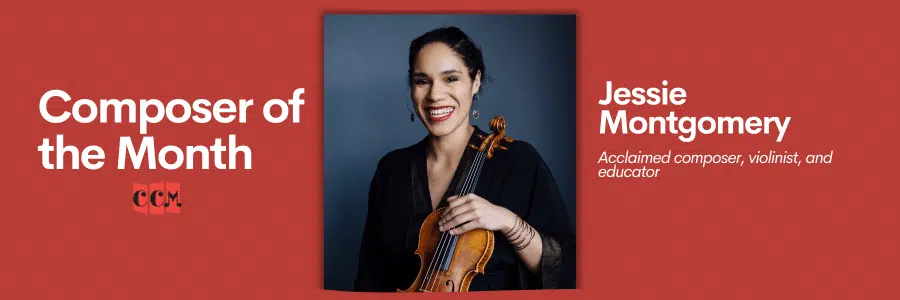
Jessie Montgomery is a vibrant force in contemporary classical music! We celebrate her inventive compositions and dedication to social issues through music. As a violinist, composer, and music educator, Montgomery’s works resonate with her diverse experiences and commitment to community engagement. Her music blends classical music traditions with elements from various genres, creating fresh, captivating soundscapes that speak to her audiences.
Early Life and Inspirations
Born in New York City, Jessie Montgomery grew up immersed in the arts. Her parents, both musicians, instilled in her a deep appreciation for music and cultural diversity. From a young age, Montgomery was exposed to a mix of classical, jazz, and folk music, which influenced her compositional style. She began studying violin at the Third Street Music School Settlement and quickly showed a profound affinity for music. Musical performances at community events from her childhood shaped her belief in music as a vital tool for social change.
Montgomery’s Music Career
Montgomery’s dual roles as a performer and composer marks her professional journey in music. After studying at the Juilliard School, she joined the Catalyst Quartet and contributed to promoting diversity in music. Her career as a composer took off as she began to explore the intersections of her identity and historical narratives in her compositions. Montgomery has received commissions from major orchestras and ensembles, including the New York Philharmonic and the Orpheus Chamber Orchestra, showcasing her ability to engage with traditional formats while injecting them with new life.
Unique Aspects of Her Music
Montgomery’s music is distinguished by its rhythmic complexity and vibrant tonal colors. She often incorporates elements of improvisation, American folk idioms, and electronic music, reflecting her versatile musical background. Moreover, her compositions frequently address themes of historical significance and social justice, aiming to evoke emotional responses and provoke thought. Montgomery’s approach to composition is deeply intertwined with her educational endeavors, as she strives to make classical music accessible and relevant to underrepresented communities.
Montgomery’s Works and Themes
Among Montgomery’s notable works, “Starburst” exemplifies her energetic and dynamic style, employing rapid changes and vibrant string techniques. Another significant composition, “Banner,” serves as a tribute to the bicentennial of the U.S. National Anthem, blending anthems from various cultures to reflect America’s diverse heritage. “Strum,” perhaps her most celebrated piece, merges the rhythmic freedom of American folk music with the intricate textures of classical string writing, creating a lively and engaging piece that has captivated audiences globally.
Final Thoughts
Jessie Montgomery’s contributions to the world of classical music extend far beyond her compositions. Overall, her work as an educator and advocate for diversity within the arts continues to inspire new generations of musicians. Montgomery’s music does not merely entertain; it challenges, communicates, and connects. As a result, her music offers new perspectives on the role of classical music in contemporary society. As we celebrate her as the February Composer of the Month, we look forward to her continued influence and innovation in the music world.
Sign up for a FREE introductory music lesson at The California Conservatory of Music today!

Violin January Student of the Month: Emma Lee

This January, we are featuring CCM violin student, Emma Lee as our student of the month! Emma has been taking violin lessons at CCM for over a year now with Teacher Kourosh at our Redwood City location. Teacher Kourosh says, “Emma is always a delight to work with. She is consistently prepared, focused, and curious. She often learns new songs of her own initiative, and always tries hard to play everything well. I’m very proud of her!”
We are happy to have Emma as part of the CCM community and we look forward to watching her progress continue!
Student of the Month Questionnaire – Emma Lee
What is your name?
Emma Lee
How old are you?
10 years old
Who is your teacher?
Teacher Kourosh
How long have you been taking violin lessons?
1.5 years!
What advice would you give to a violin student just starting at CCM?
Practice a lot and stick with it. If you want to get really good at a specific song, you need to practice hard, take your time on it, and focus. If you are having trouble with the bow crossings slow down and place your fingers in the right position first and then bow. Your elbow hieght controls the angle of the bow. Trust your instructor to guide you.
What piece are you looking forward to learning someday?
Lose Control by Teddy Swims
What is your favorite thing about playing violin?
It’s the most beautiful sounding instrument
What is your favorite food?
My top four (because I don’t just have one): Burgers, Sushi, Ramen, and Donuts!
Do you have a pet?
I don’t have any pets now, but I used to have a pet beta fish
Do you play any sports or do any other activities outside of music lessons?
Yes, I play Basketball and Volleyball, and I am in our school musical, Frozen.
What do you want to be when you grow up?
I would like to be a Sports Analyst, a Physical Therapist, or a Software Programmer.
What is your most memorable experience at CCM?
My first recital.
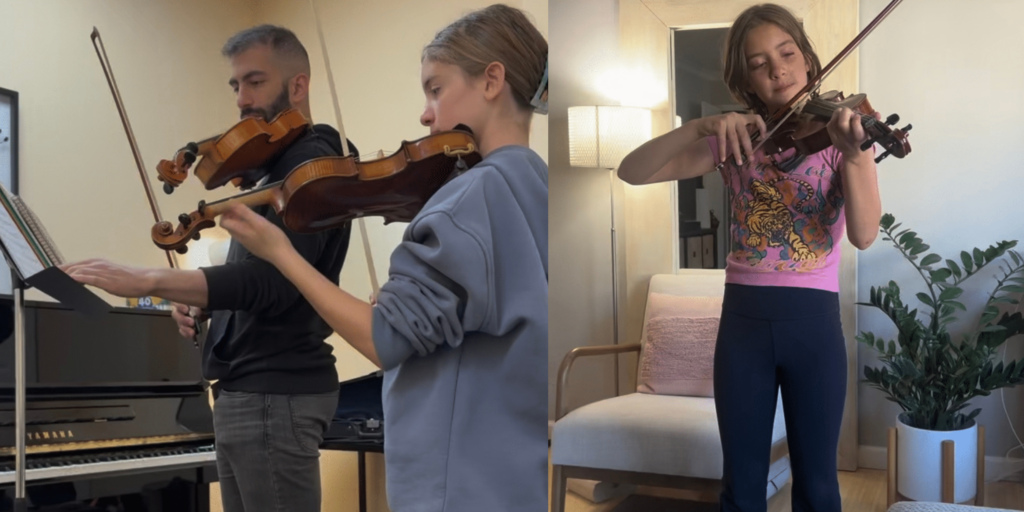
Parent Spotlight – Nicole Carvalho-Lee
I am most proud of Emma’s patience, and perseverance in learning such a challenging instrument. She has been dedicated to learning it and puts time and effort into it.
Be patient with your child, and support them when they are practicing. I have found it very helpful to learn what Emma is learning so I can support her at home.
Why did you decide to give your child a musical upbringing?
Emma expressed interest in playing violin so we honored her request to learn.
Sign up for a FREE introductory music lesson at The California Conservatory of Music today!

Django Reinhardt: January Musician of the Month
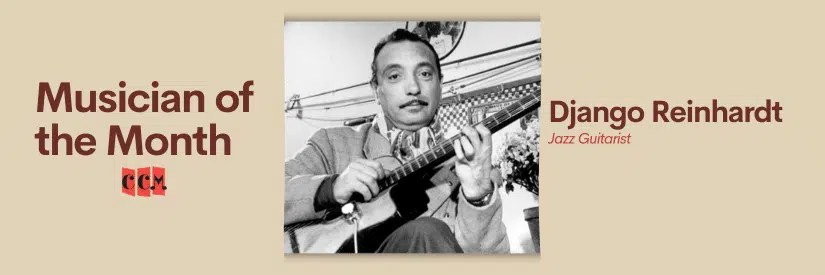
Django Reinhardt stands as a monumental figure in the world of jazz music, renowned for his influence on jazz guitar. Born in Belgium and raised in a Manouche Romani family, his music represents his rich cultural background. Despite facing tremendous personal challenges, including a severe injury to his hand, Django’s innovative techniques and compositions have left an indelible mark on the jazz genre, particularly in the style known as hot club style jazz.
Early Life and Inspirations
Born in 1910 in Liberchies, Belgium, Django Reinhardt grew up in a nomadic family steeped in musical tradition. His early exposure to music came through his family, particularly his father who played the violin. By the age of eight, Django had taught himself to play the guitar and banjo. The vibrant musical environment of his community nurtured his burgeoning talent. His early life was not just about music; it was about surviving through art, which later heavily influenced his playing style and musical choices.
Django’s Music Career
Django’s career took a pivotal turn after he survived a caravan fire at the age of 18, which severely damaged his left hand. Despite this setback, he developed a revolutionary technique to play guitar using only two fingers on his fretting hand. His resilience propelled his career forward, and by the 1930s, he was performing in Paris’ most popular clubs. Django co-founded the Quintette du Hot Club de France with violinist Stéphane Grappelli, one of the first all-string jazz bands, which became hugely successful. Their music blended American jazz with French musette and Eastern European influences, creating a new, exciting sound.
Unique Aspects of Django’s Music
Django’s music is characterized by its vigorous rhythm and swift guitar technique, which brought a new energy to jazz guitar playing. His ability to blend elements from various musical genres—classical, flamenco, and traditional Manouch Romani music—into jazz was revolutionary. Django’s improvisational skill was unmatched, often weaving complex harmonies and melodies with apparent ease. His compositions, such as “Minor Swing” and “Nuages,” remain jazz standards, beloved for their lyrical beauty and technical prowess. Django’s influence extends beyond jazz; he has inspired generations of guitarists across various music genres.
Notable Works and Themes
Django Reinhardt’s contributions to music include over 100 recordings and numerous compositions that have become jazz standards. “Minor Swing,” as mentioned, is perhaps his most famous piece, encapsulating the essence of hot club jazz with its vibrant and infectious energy. Another significant work, “Nuages,” showcases Django’s softer, more melodic side, offering a contrast to his usually fiery compositions. These pieces not only highlight his technical skill but also his ability to convey deep emotions through music. His work during the 1940s, including sessions with American jazz legends like Duke Ellington, further cemented his legacy as a jazz icon.
Final Thoughts
Django Reinhardt’s story is one of triumph over adversity, creativity in the face of limitations, and the enduring power of music. His contributions to jazz are profound and enduring, with his style and techniques continuing to influence musicians around the globe. Django did not just play music; he lived it, and his life’s work continues to resonate with anyone who values the art of sound. Celebrating Django Reinhardt is to celebrate the spirit of innovation and the perpetual joy of musical exploration.
Sign up for a FREE introductory music lesson at The California Conservatory of Music!

Unsuk Chin: January Composer of the Month
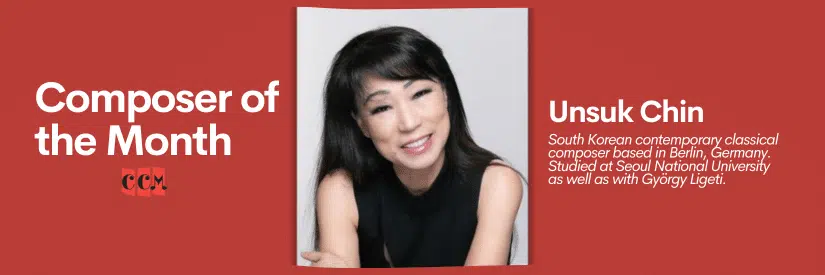
Unsuk Chin is a name that resonates with innovation and avant-garde composition in contemporary classical music. Born and educated in Seoul before moving to Europe to refine her craft, Chin has consistently pushed the boundaries of musical expression. Her works are celebrated worldwide for their technical complexity and vibrant imagination, making her one of the most influential composers of our modern time.
Early Life and Inspirations
Unsuk Chin’s musical journey began in Seoul, South Korea, where she was born in 1961. From a young age, she had a profound connection to music, initially inspired by the Western classical records her father played at home. Chin pursued formal music education at Seoul National University, focusing on piano and composition. The rigorous training she received laid the foundation for her innovative approach to music. Her early compositions reflect a daring exploration of sound, a theme that she has continued to develop throughout her career.
Chin’s Music Career
Chin’s move to Europe marked a pivotal phase in her career. She studied under György Ligeti in Hamburg, who greatly influenced her compositional style. Under his mentorship, Chin embraced complexity and unconventional structures, which became hallmarks of her work. Her professional breakthrough came with the premiere of “Akrostichon-Wortspiel,” a piece that gained international acclaim and showcased her unique voice in modern composition. Since then, Chin has received numerous prestigious awards, including the Grawemeyer Award for Music Composition and the Wihuri Sibelius Prize.
Unique Aspects of Chin’s Music
Chin’s music is known for its intricate textures and vibrant sonic colors. She often incorporates elements of electronic music, extended instrumental techniques, and influences from non-Western musical traditions. This fusion creates a distinctive auditory experience that challenges and captivates audiences. Furthermore, Chin is adept at blending philosophical and literary references into her compositions, adding layers of depth and meaning. Her innovative use of the orchestra and her bold approach to vocal composition have set new standards in contemporary music.
Notable Works and Themes
Among Chin’s most celebrated works is “Alice in Wonderland,” an opera that exemplifies her ability to translate complex narratives into compelling musical language. The opera combines surrealism with rigorous composition, reflecting Chin’s fascination with exploring new realms of expression. Other significant works include “Concerto for Violin and Orchestra,” which challenges both the soloist and the orchestra with its demanding techniques and intricate interplay. Her piece “Spectres,” showcases her skill in creating vivid musical images that linger in the listener’s memory.
Final Thoughts
Unsuk Chin’s contributions to contemporary music are profound and enduring. Through her innovative compositions, she has opened up new possibilities for expression within the classical music genre. Her work not only entertains but also provokes thought and emotional response, bridging the gap between traditional orchestration and futuristic sounds. As we explore her compositions, we are reminded of the power of music to transcend boundaries and redefine the limits of our imagination. Chin’s legacy is one of relentless exploration and enduring impact, inspiring both audiences and future composers to envision what music can be in a constantly evolving world.
Sign up for your FREE lesson at The California Conservatory of Music today!

Vince Guaraldi: December Musician of the Month

As December rolls in, you can hear the melodies of Vince Guaraldi’s jazz compositions all around. You may especially recognize the famous melodies from “A Charlie Brown Christmas”! Vince Guaraldi is a jazz pianist and composer whose tunes have become synonymous with holiday cheer and childhood nostalgia. His unique jazz contributions have left an indelible mark on the genre and popular culture.
Early Life and Inspirations
Vincent Anthony Guaraldi was born in 1928 in San Francisco, California. The burgeoning jazz scene of the Bay Area deeply influenced him as he grew up. Guaraldi’s early exposure to jazz legends like Art Tatum and Dave Brubeck ignited his passion for the genre. He began his musical journey as a self-taught musician, showcasing a natural affinity for the piano. His formal education at San Francisco State University further honed his skills and deepened his love for jazz.
Guaraldi’s Music Career
Guaraldi’s professional career took off in the early 1950s when he joined Cal Tjader’s Latin jazz ensemble as a pianist. This experience was instrumental in shaping his musical style, which seamlessly blended traditional jazz with Brazilian and Latin rhythms. In 1955, Guaraldi left Tjader’s group to form his own trio, marking the beginning of a prolific solo career. His breakthrough came with the release of “Jazz Impressions of Black Orpheus” in 1962, which included the hit “Cast Your Fate to the Wind.” This track not only earned him a Grammy but also established him as a significant figure in the jazz world.
Unique Aspects of Guaraldi’s Music
Guaraldi’s music is distinguished by its simplicity and emotional depth. His ability to convey profound emotion through minimalistic arrangements set him apart from his contemporaries. Guaraldi’s style is warm and accessible, characterized by catchy melodies and a playful approach to rhythm and phrasing. His music often serves as a bridge between jazz and popular music, appealing to both jazz aficionados and casual listeners alike. Furthermore, his work with the Peanuts animated specials infused his jazz compositions with a whimsical and nostalgic quality that has enchanted generations.
Notable Works and Themes
Vince Guaraldi’s most celebrated work is undoubtedly his score for “A Charlie Brown Christmas.” This soundtrack, featuring classics like “Linus and Lucy” and “Christmas Time Is Here,” is a staple of holiday music that has influenced how generations perceive and appreciate jazz music. His work on other Peanuts specials, such as “It’s the Great Pumpkin, Charlie Brown” and “A Charlie Brown Thanksgiving,” also demonstrates his versatility and ability to capture the essence of each story through music. Guaraldi’s contributions to these animations helped elevate the medium, demonstrating how music could enhance storytelling in animated formats.
Final Thoughts
Vince Guaraldi’s legacy as a musician and composer is profound. His innovative approach to jazz and his ability to reach audiences of all ages have made his music a significant part of popular culture. As we celebrate him this December, we remember a musician who brought joy and sophistication to his art, leaving us with melodies that echo through time, especially during the festive season. Guaraldi’s music remains a testament to the enduring power of melody and emotion, resonating with listeners long after the holiday decorations have been packed away.
Vince Guaraldi’s music continues to inspire and delight listeners around the world, embodying the spirit of the season and the enduring appeal of well-crafted jazz. As we listen to his timeless compositions, we are reminded of the joy and warmth that music can bring into our lives, making this holiday season all the more special with every note played.
Sign up for a FREE introductory lesson at The California Conservatory of Music today!

